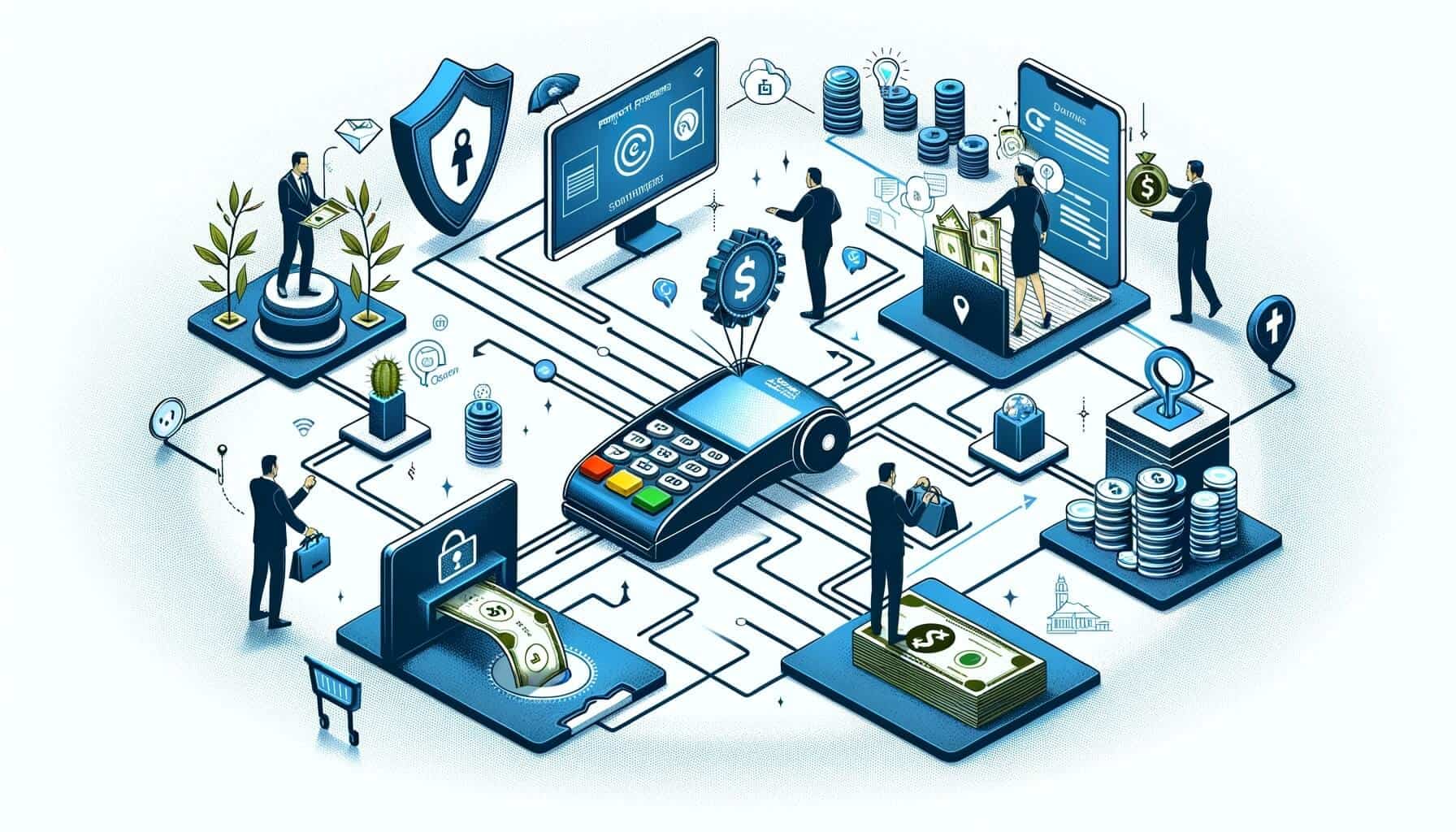
By Ava Owen March 19, 2025
In today’s digital age, payment processing systems play a crucial role in facilitating seamless and secure transactions between buyers and sellers. Whether it’s an online purchase, a credit card transaction at a physical store, or a mobile payment, payment processing systems ensure that funds are transferred from the buyer’s account to the seller’s account efficiently and securely.
This comprehensive article will delve into the intricacies of payment processing systems, exploring their components, functionality, security measures, supported payment methods, authorization and settlement processes, as well as common challenges and solutions.
Understanding the Components of a Payment Processing System

A payment processing system consists of several key components that work together to facilitate the transfer of funds. These components include payment gateways, merchant accounts, and payment processors.
1. Payment Gateways: Payment gateways act as the intermediary between the buyer, the seller, and the financial institutions involved in the transaction. They securely transmit transaction data between these parties, encrypting sensitive information to protect it from unauthorized access. Payment gateways also perform tasks such as fraud detection, address verification, and currency conversion.
2. Merchant Accounts: Merchant accounts are specialized bank accounts that allow businesses to accept payments from customers. These accounts are typically set up with acquiring banks or payment service providers. Merchant accounts store funds received from transactions until they are settled into the business’s regular bank account.
3. Payment Processors: Payment processors are the entities responsible for handling the actual processing of transactions. They receive transaction data from payment gateways, verify the availability of funds, and initiate the transfer of funds from the buyer’s account to the seller’s account. Payment processors also handle tasks such as transaction reconciliation, reporting, and chargeback management.
The Role of Payment Gateways in Processing Transactions

Payment gateways play a crucial role in processing transactions by securely transmitting transaction data between the buyer, the seller, and the financial institutions involved. They act as the bridge that connects various parties and ensures the smooth flow of information.
1. Transaction Encryption: Payment gateways use encryption protocols to protect sensitive data, such as credit card numbers, from being intercepted and misused. This encryption ensures that the data transmitted between the buyer and the seller remains confidential and secure.
2. Fraud Detection: Payment gateways employ sophisticated fraud detection mechanisms to identify and prevent fraudulent transactions. They analyze various factors, such as transaction patterns, IP addresses, and device information, to detect suspicious activities and flag potential fraud.
3. Address Verification: Payment gateways often integrate address verification systems to validate the billing address provided by the buyer. This helps reduce the risk of fraud by ensuring that the address matches the one associated with the buyer’s payment card.
Exploring the Functionality of Merchant Accounts

Merchant accounts are essential for businesses to accept payments from customers. They provide a secure and efficient way to receive funds and manage transactions. Let’s explore the functionality of merchant accounts in more detail.
1. Funds Storage: Merchant accounts serve as temporary storage for funds received from transactions. When a customer makes a payment, the funds are held in the merchant account until they are settled into the business’s regular bank account. This allows businesses to manage their cash flow effectively.
2. Transaction Settlement: Merchant accounts facilitate the settlement process, which involves transferring funds from the buyer’s account to the seller’s account. Settlement can occur in real-time or on a scheduled basis, depending on the payment processor and the agreement between the business and the acquiring bank.
3. Reporting and Analytics: Merchant accounts provide businesses with detailed reports and analytics on their transactions. These reports help businesses track sales, identify trends, and make informed decisions to optimize their payment processing strategies.
The Importance of Payment Processors in the System

Payment processors are the backbone of payment processing systems, responsible for handling the actual processing of transactions. They ensure that funds are transferred securely and efficiently between the buyer and the seller. Let’s delve into the importance of payment processors in more detail.
1. Transaction Verification: Payment processors verify the availability of funds in the buyer’s account before initiating the transfer. This verification process helps prevent insufficient funds transactions and reduces the risk of chargebacks.
2. Transaction Reconciliation: Payment processors reconcile transactions by matching the transaction data received from the payment gateway with the corresponding settlement data. This ensures that all transactions are accurately recorded and accounted for.
3. Chargeback Management: Payment processors handle chargebacks, which occur when a buyer disputes a transaction and requests a refund. They facilitate the communication between the buyer, the seller, and the issuing bank to resolve the dispute and ensure a fair outcome.
Security Measures in Payment Processing Systems
Security is of paramount importance in payment processing systems to protect sensitive customer data and prevent fraudulent activities. Let’s explore some of the security measures implemented in these systems.
1. Data Encryption: Payment processing systems use encryption protocols, such as SSL (Secure Sockets Layer) or TLS (Transport Layer Security), to encrypt sensitive data during transmission. This ensures that the data remains confidential and cannot be intercepted by unauthorized parties.
2. Tokenization: Tokenization is a security measure that replaces sensitive data, such as credit card numbers, with unique tokens. These tokens are used for transaction processing, while the actual data is securely stored in a separate system. Tokenization reduces the risk of data breaches and minimizes the impact of a potential breach.
3. PCI DSS Compliance: Payment processing systems adhere to the Payment Card Industry Data Security Standard (PCI DSS), a set of security standards established by major card brands. Compliance with PCI DSS ensures that businesses handle cardholder data securely and reduces the risk of data breaches.
Different Types of Payment Methods Supported by Payment Processors
Payment processors support a wide range of payment methods to cater to the diverse needs of buyers and sellers. Let’s explore some of the most common payment methods supported by payment processors.
1. Credit and Debit Cards: Payment processors enable businesses to accept payments from major credit and debit cards, such as Visa, Mastercard, American Express, and Discover. These cards are widely used by consumers for online and offline purchases.
2. Mobile Payments: With the rise of smartphones, payment processors have integrated support for mobile payment methods, such as Apple Pay, Google Pay, and Samsung Pay. These mobile wallets allow users to make contactless payments using their smartphones or smartwatches.
3. E-Wallets: E-wallets, also known as digital wallets, are virtual wallets that store payment card information and other payment credentials. Payment processors support popular e-wallets like PayPal, Alipay, and WeChat Pay, enabling users to make secure and convenient online payments.
The Process of Authorization and Settlement in Payment Processing
The authorization and settlement processes are crucial steps in payment processing systems that ensure the smooth transfer of funds between the buyer and the seller. Let’s explore these processes in more detail.
1. Authorization: When a buyer initiates a payment, the payment gateway sends the transaction data to the payment processor for authorization. The payment processor verifies the availability of funds in the buyer’s account and performs additional checks, such as fraud detection and address verification. If the transaction is approved, the payment processor sends an authorization code to the payment gateway.
2. Settlement: After the transaction is authorized, the settlement process begins. The payment processor initiates the transfer of funds from the buyer’s account to the seller’s account. Depending on the payment method and the agreement between the parties involved, settlement can occur in real-time or on a scheduled basis. Once the funds are settled, they are transferred to the merchant account and eventually to the seller’s regular bank account.
Common Challenges and Solutions in Payment Processing Systems
While payment processing systems have revolutionized the way we transact, they also face various challenges. Let’s explore some common challenges and their solutions in payment processing systems.
1. Fraud Prevention: Fraud is a significant concern in payment processing systems. To combat this, payment processors employ advanced fraud detection mechanisms, such as machine learning algorithms and behavioral analytics, to identify and prevent fraudulent transactions. Additionally, implementing multi-factor authentication and 3D Secure protocols adds an extra layer of security.
2. Payment Disputes and Chargebacks: Payment disputes and chargebacks can be time-consuming and costly for businesses. To mitigate this, payment processors provide chargeback management services, facilitating communication between the buyer, the seller, and the issuing bank to resolve disputes efficiently. Implementing robust customer support and clear refund policies can also help reduce chargebacks.
3. Integration and Compatibility: Integrating payment processing systems with existing business infrastructure can be challenging. Payment processors offer developer-friendly APIs and plugins to simplify integration. Additionally, ensuring compatibility with various payment methods and currencies is crucial to cater to a global customer base.
FAQs
Q1. What is a payment processing system?
Answer: A payment processing system refers to the infrastructure and technology that enables the transfer of funds from a customer’s account to a merchant’s account.
Q2. What is a payment gateway?
Answer: A payment gateway acts as a bridge between the merchant’s website or application and the acquiring bank. It securely captures and encrypts customer payment information, authorizes transactions, and transfers the funds to the merchant’s account.
Q3. What is a merchant account?
Answer: A merchant account is a type of bank account that allows businesses to accept and process payments. It serves as an intermediary between the merchant and the acquiring bank, where funds from customer transactions are deposited.
Q4. How do payment processors ensure security?
Answer: Payment processors ensure security through encryption, tokenization, and compliance with PCI DSS. These measures protect customer payment information and prevent unauthorized access.
Q5. What payment methods are supported by payment processors?
Answer: Payment processors support various payment methods, including credit and debit cards, mobile wallets, bank transfers, and alternative payment methods like cryptocurrencies.
Conclusion
Payment processing systems are the backbone of modern commerce, enabling seamless and secure transactions between buyers and sellers. Understanding the components, functionality, and security measures of these systems is essential for businesses and consumers alike.
By leveraging payment gateways, merchant accounts, and payment processors, businesses can offer a wide range of payment methods, ensure transaction security, and streamline their financial operations. While challenges exist, continuous advancements in technology and fraud prevention measures are paving the way for even more efficient and secure payment processing systems in the future.